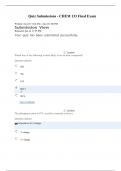Chem133 week Study guides, Class notes & Summaries
Looking for the best study guides, study notes and summaries about Chem133 week? On this page you'll find 93 study documents about Chem133 week.
Page 4 out of 93 results
Sort by
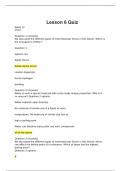
-
CHEM133 Week 13 Lesson 6 Quiz
- Exam (elaborations) • 13 pages • 2023
- Available in package deal
-
- $32.10
- + learn more
1. Question: We discussed the different types of intermolecular forces in this lesson. Which is the strongest in CF2H2 ? 2. Question: Water is such a special molecule with some really unique properties. Why is it so unusual? 3. Question: We discussed the different types of intermolecular forces in this lesson, which can affect the boiling point of a substance. Which of these has the highest boiling point? 4. Question: If you have 2.00 x 103 J of energy, what mass (g) of solid butane (C4H10O) ...
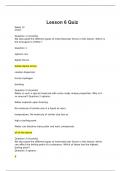
-
CHEM133 Week 13 Lesson 6 Quiz
- Exam (elaborations) • 13 pages • 2023
-
- $22.49
- + learn more
1. Question: We discussed the different types of intermolecular forces in this lesson. Which is the strongest in CF2H2 ? 2. Question: Water is such a special molecule with some really unique properties. Why is it so unusual? 3. Question: We discussed the different types of intermolecular forces in this lesson, which can affect the boiling point of a substance. Which of these has the highest boiling point? 4. Question: If you have 2.00 x 103 J of energy, what mass (g) of solid butane (C4H10O) ...
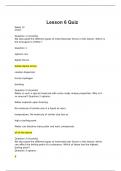
-
CHEM133 Week 13 Lesson 6 Quiz (All Correct)
- Exam (elaborations) • 13 pages • 2023
- Available in package deal
-
- $25.48
- + learn more
1. Question: We discussed the different types of intermolecular forces in this lesson. Which is the strongest in CF2H2 ? 2. Question: Water is such a special molecule with some really unique properties. Why is it so unusual? 3. Question: We discussed the different types of intermolecular forces in this lesson, which can affect the boiling point of a substance. Which of these has the highest boiling point? 4. Question: If you have 2.00 x 103 J of energy, what mass (g) of solid butane (C4H10O) ...
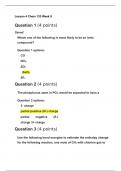
-
CHEM133 Week 9 Lesson 4 Quiz
- Exam (elaborations) • 12 pages • 2023
- Available in package deal
-
- $32.10
- + learn more
1. Question: Which one of the following is most likely to be an ionic compound? 2. Question: The phosphorus atom in PCl3 would be expected to have a 3. Question: The phosphorus atom in PCl3 would be expected to have a give CH3Cl and hydrogen chloride. 4. Question: How many of the following molecules have no dipole moment? 5. Question: Atoms having equal or nearly equal electronegativities are expected to form 6. Question: Element A has an electronegativity of 0.8 and element B has an electr...
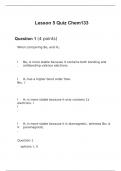
-
CHEM133 Week 11 Lesson 5 Quiz
- Exam (elaborations) • 17 pages • 2023
-
- $21.49
- + learn more
1. Question: When comparing Be2 and H2: 2. Question: Atoms that are sp2 hybridized form ____ pi bond(s). 3. Question: The hybridization of the nitrogen atom in the cation NH2+ is: 4. Question: Which one of the following molecules has an atom with an incomplete octet? 5. Question: Nitrous oxide (N2O) is sometimes called "laughing gas". What is the formal charge on the central nitrogen atom in the most favorable Lewis structure for nitrous oxide based on minimizing formal charge overall? 6....
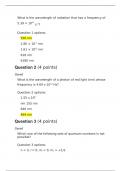
-
CHEM133 Week 6 Lesson 3 Quiz
- Exam (elaborations) • 16 pages • 2023
-
- $21.49
- + learn more
1. Question: What is the wavelength of radiation that has a frequency of 5.39 × 1014 s–1? 2. Question: What is the wavelength of a photon of red light (nm) whose frequency is 4.64 x 1014 Hz? 3. Question: Which one of the following sets of quantum numbers is not possible? 4. Question: In Bohr's atomic theory, when an electron moves from one energy level to another energy level more distant from the nucleus: 5. Question: Calculate the wavelength of a neutron that has a velocity of 250 cm/s...
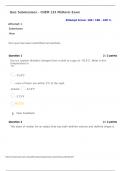
-
CHEM133 Week 7 Midterm Exam (Spring) Questions and Answers APU
- Exam (elaborations) • 26 pages • 2023
- Available in package deal
-
- $32.99
- + learn more
1. Question: Dry ice (carbon dioxide) changes from a solid to a gas at –78.5°C. What is this temperature in °F? 2. Question: The state of matter for an object that has both definite volume and definite shape is 3. Question: In 1828, the diameter of the U.S. dime was changed to approximately 18 mm. What is this diameter when expressed in nanometers? 4. Question: A piece of antimony with a mass of 17.41 g is submerged in 46.3 cm3 of water in a graduated cylinder. The water level increases t...
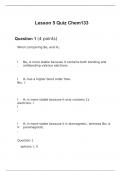
-
CHEM133 Week 11 Lesson 5 Quiz Questions and Answers APU
- Exam (elaborations) • 17 pages • 2023
- Available in package deal
-
- $23.99
- + learn more
1. Question: When comparing Be2 and H2: 2. Question: Atoms that are sp2 hybridized form ____ pi bond(s). 3. Question: The hybridization of the nitrogen atom in the cation NH2+ is: 4. Question: Which one of the following molecules has an atom with an incomplete octet? 5. Question: Nitrous oxide (N2O) is sometimes called "laughing gas". What is the formal charge on the central nitrogen atom in the most favorable Lewis structure for nitrous oxide based on minimizing formal charge overall? 6....
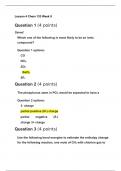
-
CHEM133 Week 9 Lesson 4 Quiz (All Correct)
- Exam (elaborations) • 12 pages • 2023
- Available in package deal
-
- $25.48
- + learn more
1. Question: Which one of the following is most likely to be an ionic compound? 2. Question: The phosphorus atom in PCl3 would be expected to have a 3. Question: The phosphorus atom in PCl3 would be expected to have a give CH3Cl and hydrogen chloride. 4. Question: How many of the following molecules have no dipole moment? 5. Question: Atoms having equal or nearly equal electronegativities are expected to form 6. Question: Element A has an electronegativity of 0.8 and element B has an electr...



